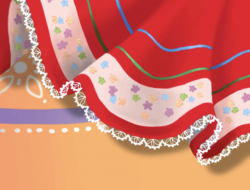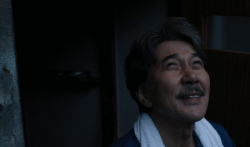There is something about Gerhard Richter’s paintings which sets them apart from the works of most of the post-modernists and neo-expressionists he is typically associated with: they are pretty. Pretty in a way that transcends their typically grim spectra. Say what you will for the theoretical implications of his blurred portraits and crackling abstracts, they are first and foremost the work of a man with a hell of an eye.
Gerhard Richter: Forty Years of Painting, now on display at the Hirschhorn Museum, is a collection of paintings from across the artist’s career, from the early ‘60s to the present. Richter’s paintings can generally be divided into two camps: photorealist portraits and landscapes, often paradoxically blurred, and energetic abstracts. This show brings together paintings good and bad from both camps, and also includes most of Richter’s best-known works, his paintings copied from photographs of high-profile victims and criminals.
These victims and criminals include the eight student nurses murdered by Richard Speck in Chicago in 1966, and members of the Baader-Meinhof gang, which terrorized West Germany throughout the 1970s. Richter’s paintings of the nurses, done the very same year of the murders from yearbook photos printed in a newspaper, are startling portraits in which the nurses are rendered sometimes perfectly, flawlessly, and sometimes with grotesquely pulled smiles and gaping mouths that mirror their bobbed hairstyles. The overall effect is of portraiture enhanced.
Richter’s Baader-Meinhof project, undertaken in 1988, was an inherently charged one, as the gang’s demise was and remained a divisive political moment-most of the members were taken into custody in the late ‘70s, where they died in under somewhat dubious circumstances. These paintings were made from photos, and many have a clinically graphic feel that Richter conveys not through visual detail, but through blurring the images, a task for which he has a variety of approaches. He runs portraits through a sine-wave pull, like a run in a stocking. He simply smudges paintings with a wet sponge, leaving every boundary a gradient. And, of course, he uses a thousand intervals between and beyond. The overall effect is always to heighten the sensation, to apply a tint of abstraction that serves not first and foremost as a theoretical statement, but instead as a means to visual access. His trio of head shots of a dead gang member lying on black floor yield the very sensation of that floor and its contact with cold skin and bones. “Record Player,” a painting of the turntable that Baader reportedly used to hide the gun he killed himself with, animates the object. Caught on the camera of Richter’s canvas, it appears coy, even ashamed.
Of course, these are only Richter’s most famed paintings, and he has plenty of other excellent work. Other blurry delights include “Woman Descending the Staircase,” a 1965 portrait of a woman, all shimmering dress and electric silver haze, doing just that, her arms spread out behind her as she sets her foot down. “Helga Maura with her Fianc?e” is another startling mid-’60s painting of a murder victim, in which Richter gives just enough definition so you can make out the lazy squint of the bow’s eyes, and her thick, slight smile.
Richter has also painted a number of more conventional photorealist pictures, of which this show only includes a smattering. “Reader,” a soft, glowing portrait from the ‘90s of a woman reading a newspaper, is one of the better ones, a restrained, almost humble picture. “48 Portraits,” on the other hand, is an impressive array of famed, mostly dead white guys copied from pictures in an encyclopedia. Peering out under furrowed brows, they’re a strangely fitting tribute.
Towards the back of the exhibit, you will find some of Richter’s more recent abstracts. Throughout his career, he has painted in a variety of styles, and this is clearly represented at the show, often to its detriment; his wandering squiggles and bolts of neon color from the ‘70s and ‘80s feel dated. But by the early ‘90s his abstracts had begun to gel. Richter started painting sheets of glass and other surfaces and holding them against his canvases to apply the paint. Many of the resulting abstract pictures have colors with incredibly pure boundaries, as each layer has its own powerful surface tension. “Abstract Picture, Kine,” from 1995, is one such painting, a digitized jumble of contrasting layers, each of which feel distinct in time and space. Maroon bruises encroach on the surface, like flame burning through a piece of paper, and a dull haze, like a tinge of TV static, hangs over the entire composition. Richter’s late abstracts are some of his finest work, and their beauty is indicative of his emphasis on aesthetics over theories. As Richter once put it, they are “the complete opposite of randomness.”
Gerhard Richter: Forty Years of Painting is on show now at the Hirschhorn Museum through May 18. Admission is free.




